Process for the preparation of a starch ester
a technology of starch ester and process, which is applied in the preparation of sugar derivatives, esterified saccharide compounds, sugar derivatives, etc., can solve the problems of hampered prior art processes, achieve the effect of easy control of reaction temperature, easy regulation of desired ds, and short reaction tim
- Summary
- Abstract
- Description
- Claims
- Application Information
AI Technical Summary
Benefits of technology
Problems solved by technology
Method used
Image
Examples
working examples
Examples 1 and 2
As catalyst, NaOH; desired D.S. 2.5 and 3.0; initial starch material native barley starch.
Metering of reactants, catalyst and solvent as indicated in Table 1:
examples 3 to 6
In examples 3 to 6, sodium acetate was used as the catalyst in varying amounts. The reaction temperature was also changed. The examples illustrate changes in reaction velocity and in the hydrolyzation of the starch as a function of these parameters.
example 7
As in Examples 1 to 6, except that sulphuric acid was used as the catalyst. Sulphuric acid possesses intensive hydrolyzation properties.
The results are indicated in Table 3.
PUM
| Property | Measurement | Unit |
|---|---|---|
| temperature | aaaaa | aaaaa |
| pressure | aaaaa | aaaaa |
| pressure | aaaaa | aaaaa |
Abstract
Description
Claims
Application Information
 Login to View More
Login to View More - R&D
- Intellectual Property
- Life Sciences
- Materials
- Tech Scout
- Unparalleled Data Quality
- Higher Quality Content
- 60% Fewer Hallucinations
Browse by: Latest US Patents, China's latest patents, Technical Efficacy Thesaurus, Application Domain, Technology Topic, Popular Technical Reports.
© 2025 PatSnap. All rights reserved.Legal|Privacy policy|Modern Slavery Act Transparency Statement|Sitemap|About US| Contact US: help@patsnap.com


